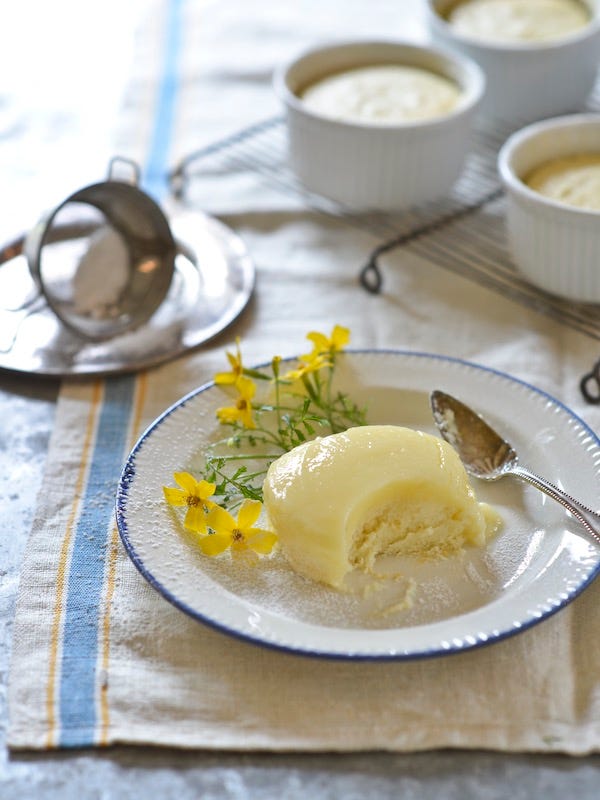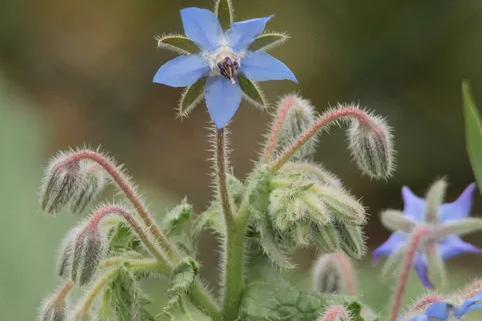Tasteful Flowers
Tasteful Flowers
It’s a humbling reminder that eating flowers is nothing new. The bees have known all along how good flowers can be. Now it’s our turn
“We might think we are nurturing our garden, but of course it is our garden nurturing us.”
Welcome to the Art of Growing Food newsletter. I’m Ellen Ecker Ogden author of The New Heirloom Garden and five other books featuring kitchen garden designs with recipes for cooks who love to garden. Every week, you’ll find artful growing tips and ideas for fresh eating from your kitchen garden, to make your own garden a sanctuary for outdoor living.

Hello Everyone.
Borage is blooming in my garden right now. It is a rambling plant, with expansive hairy leaves and a sprawling habit. The foliage makes a calming tisane with a slight cucumber flavor, yet I prefer to harvest the tiny iridescent blue star-shaped flowers to garnish a chilled Gazpacho soup. Capturing these delicate beauties to adorn salads, or jazz up a dinner plate is the easiest way of bringing the garden to the table.
Flowers add eye appeal and enhance sensory qualities in ways you may not even notice. Edible flowers are everywhere, in our gardens, and in the wild. The best way to get to know which edible flowers to use is to taste the petals because not all flowers taste good. Some are herbal and honey filled while others can be peppery.

Taste, Color, and Fragrance
Flowers and vegetables are equal partners in my kitchen garden because they work in tandem with each other. The flowers attract pollinators, which give the crops a boost. From years of growing and tasting different varieties, I’ve developed a few favorites which include the most familiar of edible flower: nasturtiums. I’ve grown over 25 different types of nasturtiums from blazing red with peppery hot colors and spicy flavor, to gentle pale yellow blossoms known as Moonlight.
The truth is that each nasturtium will taste a little different. My favorite is an old heirloom variety called Phoenix, with frilly leaves and a vining habit that stretches over the boxwood in the front of the house border.
My original seeds were bought from Select Seeds, yet now I save my own seeds from year to year by allowing the blossoms to form into brown seed pods at the end of their growing season. Oftentimes, I allow them to self-sow, spreading around volunteer plants through the kitchen garden the following spring.

This time of year, when the planters are spilling over, why not make nasturtium butter by combining a stick of room temperature butter with two dozen nasturtium flowers, a handful of nasturtium leaves, and a clove of garlic or some chives. Combine the herbs and blend them into the butter, and it is ready to serve or freeze for later use over lightly sautéed vegetables.
Sweet herbal flowers such as anise hyssop, lavender, or beebalm add a cheerful sprig to garnish a fruit dessert or churned it into a floral-tasting sorbet. Separate the petals from the blossom heads for roses, calendula, and chives to decorate a composed salad, while pansies, runner beans, and arugula blossoms are delicate enough to be eaten whole.

For special occasions, I will make the classic Italian dish of stuffed zucchini flowers, blending together ricotta cheese, onions, and toasted almonds or pine nuts with grated Parmesan cheese. Season with salt and fresh basil, and once the blossoms are filled, tie the ends with a chive. Either fry in hot oil or drizzle with melted butter and bake at 350*degrees for 15 minutes.
Safe to Eat
If you are new to the world of edible flowers, check to see if they are safe to eat. A reliable list such as Edible Wild Plants: A North American Field Guide or the comprehensive database at Plants for a Future (www.pfaf.org) includes information on common and Latin names, keywords, family, habitat, and use (medicinal, edible, or other). Do not eat flowers from a florist shop, since most have been laced with pesticides and preservatives.
With more than a dozen edible flower varieties growing in my kitchen garden, borage is still one of my favorites. It’s a good sign that the bees love it, and there is something totally captivating about the brilliant blue blossoms to garnish a corn and cucumber salad or freeze into an ice cube for a summer drink. It’s a humbling reminder that eating flowers is nothing new. The bees have known all along how good flowers can be, now it’s our turn.
From my kitchen garden,
Ellen O.
Ellen Ecker Ogden
Hat tip: Claire Van de Berghe




